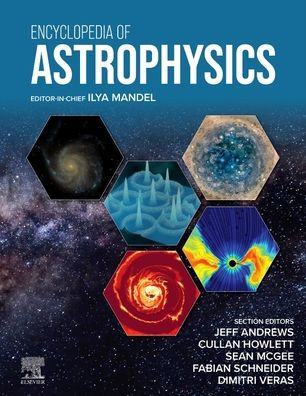With a clear and logical template binding all chapters, content is divided into the following five sections, each of which contains chapters written by leading scientists who have evaluated and summarized the most important data published within the field:
- Cosmology: including Big Bang, dark matter, dark energy, Hubble’s law, cosmic microwave background, distance ladder, BAO, lensing, tests of general relativity
- Galaxies: including morphology, galaxy zoo, active galactic nuclei, star formation / feedback / quenching, blue & red peaks and green valley, galactic chemical evolution, galaxy groups & clusters, young stellar / globular / nuclear clusters & dynamics, inter-stellar medium
- Stars: including star formation, stellar evolution, the Sun as a star, asteroseismology, stellar rotation, stellar winds, binary interactions (tides, mass transfer, common envelopes, luminous red novae…), chemical abundance, evolution
- Compact objects: including white dwarfs, neutron stars (pulsars), black holes, supernovae (type IA vs core-collapse), accretion, Eddington limit, X-ray binaries, supermassive black holes, tidal disruption events, mergers: gamma ray bursts, kilonovae, gravitational waves
- (Exo)planets: including formation, Solar system, comets / meteors, dynamics, stability, exoplanet observations (radial velocity, transits)
Advanced interactive features such as videos and 3D viewers are included, significantly increasing the practicality and learning outcomes for the modern-day reader for whom online usage is preferred. The result is the ideal one-stop foundational resource to the complex field of astrophysics and an essential tool for physicists to refer to time and again.
With a clear and logical template binding all chapters, content is divided into the following five sections, each of which contains chapters written by leading scientists who have evaluated and summarized the most important data published within the field:
- Cosmology: including Big Bang, dark matter, dark energy, Hubble’s law, cosmic microwave background, distance ladder, BAO, lensing, tests of general relativity
- Galaxies: including morphology, galaxy zoo, active galactic nuclei, star formation / feedback / quenching, blue & red peaks and green valley, galactic chemical evolution, galaxy groups & clusters, young stellar / globular / nuclear clusters & dynamics, inter-stellar medium
- Stars: including star formation, stellar evolution, the Sun as a star, asteroseismology, stellar rotation, stellar winds, binary interactions (tides, mass transfer, common envelopes, luminous red novae…), chemical abundance, evolution
- Compact objects: including white dwarfs, neutron stars (pulsars), black holes, supernovae (type IA vs core-collapse), accretion, Eddington limit, X-ray binaries, supermassive black holes, tidal disruption events, mergers: gamma ray bursts, kilonovae, gravitational waves
- (Exo)planets: including formation, Solar system, comets / meteors, dynamics, stability, exoplanet observations (radial velocity, transits)
Advanced interactive features such as videos and 3D viewers are included, significantly increasing the practicality and learning outcomes for the modern-day reader for whom online usage is preferred. The result is the ideal one-stop foundational resource to the complex field of astrophysics and an essential tool for physicists to refer to time and again.

Encyclopedia of Astrophysics
2250
Encyclopedia of Astrophysics
2250
Product Details
| ISBN-13: | 9780443214394 |
|---|---|
| Publisher: | Elsevier Science |
| Publication date: | 09/15/2025 |
| Series: | Encyclopedia of Astrophysics, Volume 1 |
| Pages: | 2250 |
| Product dimensions: | 8.50(w) x 10.88(h) x (d) |
